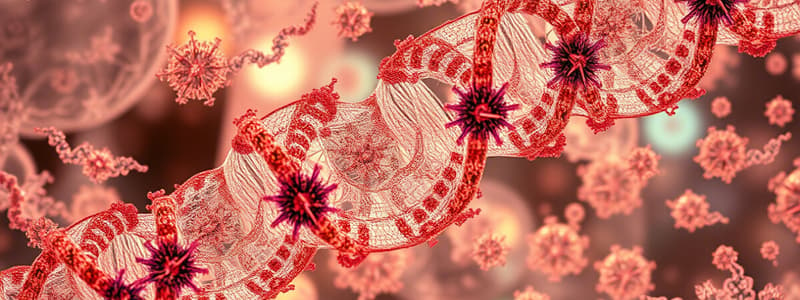Podcast
Questions and Answers
What is the primary purpose of gel electrophoresis?
What is the primary purpose of gel electrophoresis?
- To separate DNA fragments based on size (correct)
- To label nucleotides with fluorescent dyes
- To amplify DNA sequences
- To create recombinant DNA
Which factor primarily affects the movement speed of DNA fragments in gel electrophoresis?
Which factor primarily affects the movement speed of DNA fragments in gel electrophoresis?
- The type of gel used
- The size of the DNA fragments (correct)
- The length of time the voltage is applied
- The charge of the DNA fragment
What role do primers play in the Polymerase Chain Reaction (PCR)?
What role do primers play in the Polymerase Chain Reaction (PCR)?
- To separate the DNA strands
- To label the DNA fragments for sequencing
- To bind to the template and initiate DNA synthesis (correct)
- To amplify multiple DNA sequences simultaneously
What is the primary function of restriction endonuclease enzymes in recombinant DNA technology?
What is the primary function of restriction endonuclease enzymes in recombinant DNA technology?
During DNA sequencing, what is the function of the labeled nucleotide bases?
During DNA sequencing, what is the function of the labeled nucleotide bases?
How do plasmids aid in gene transformation within bacteria?
How do plasmids aid in gene transformation within bacteria?
What role do sticky ends play during the transformation process?
What role do sticky ends play during the transformation process?
How does PCR contribute to disease detection?
How does PCR contribute to disease detection?
What is the main difference between DNA splicing and DNA sequencing?
What is the main difference between DNA splicing and DNA sequencing?
What is the purpose of the Polymerase Chain Reaction (PCR)?
What is the purpose of the Polymerase Chain Reaction (PCR)?
Which statement accurately describes the functions of genetic markers in plasmids?
Which statement accurately describes the functions of genetic markers in plasmids?
In gel electrophoresis, what property of DNA causes it to move toward the positive end?
In gel electrophoresis, what property of DNA causes it to move toward the positive end?
What is the first step in the Polymerase Chain Reaction (PCR)?
What is the first step in the Polymerase Chain Reaction (PCR)?
What is a common application of recombinant DNA technology?
What is a common application of recombinant DNA technology?
What is the significance of vectors in the transformation of DNA?
What is the significance of vectors in the transformation of DNA?
Which statement is true regarding the continuous heating and cooling process used in PCR?
Which statement is true regarding the continuous heating and cooling process used in PCR?
What is the purpose of restriction enzymes in recombinant DNA technology?
What is the purpose of restriction enzymes in recombinant DNA technology?
In the process of transformation using vectors, what is the main function of the vector?
In the process of transformation using vectors, what is the main function of the vector?
Which of the following describes the Polymerase Chain Reaction (PCR)?
Which of the following describes the Polymerase Chain Reaction (PCR)?
What does DNA sequencing determine?
What does DNA sequencing determine?
Which step is involved in synthesizing polypeptides based on mRNA sequence during protein synthesis?
Which step is involved in synthesizing polypeptides based on mRNA sequence during protein synthesis?
What is a key feature of recombinant DNA technologies?
What is a key feature of recombinant DNA technologies?
What is a potential outcome of DNA manipulation using genetic engineering?
What is a potential outcome of DNA manipulation using genetic engineering?
Which term refers to changes in the DNA sequence that may occur during cell division?
Which term refers to changes in the DNA sequence that may occur during cell division?
Flashcards are hidden until you start studying
Study Notes
Gel Electrophoresis
- Method for separating DNA fragments based on size using a porous gel and electric voltage.
- Negatively charged DNA moves towards the positive electrode; smaller fragments migrate faster.
- Applications include DNA characterization, fingerprinting, genomic comparisons, and gene identification.
DNA Splicing
- Technique used to determine the identity and sequence of nucleotides in DNA.
- Involves creating complementary DNA strands using an enzyme and an original DNA template.
- Fluorescently labeled nucleotide bases are added to allow for visualization of specific sequences.
Polymerase Chain Reaction (PCR)
- Aiming to amplify specific DNA sequences, crucial for disease detection.
- Process involves heating DNA to separate strands and cooling to allow primers to bind.
- Short primers initiate DNA polymerization, leading to the formation of millions of copies through repeated cycles of heating and cooling.
Recombinant DNA Technology
- Techniques for creating recombinant DNA include transformation with vectors, vectorless gene transfer, and transduction.
Transformation Using a Vector
- Recombinant DNA creation involves using vectors, such as plasmids in bacteria, to transfer foreign DNA.
- Plasmids serve two main purposes: they provide a replication origin for inserted DNA and contain genetic markers for identification, such as antibiotic resistance.
Role of Restriction Enzymes
- Restriction enzymes cut DNA at specific sequences, creating sticky ends for new DNA to attach.
- Sticky ends facilitate the pairing of complementary DNA bases for successful gene insertion.
Genetic Vocabulary
- Replication: The biological process of duplicating a polynucleotide strand.
- Mutations: Changes in DNA sequences occurring during cell division.
- In Vitro Amplification: The technique of producing multiple copies of a specific DNA region in a laboratory setting.
- Translation: The step in protein synthesis where mRNA directs the formation of polypeptides by decoding genetic instructions.
- Anticodon: A trinucleotide sequence on tRNA that is complementary to a codon on mRNA.
- Autosome: Any chromosome that is not a sex chromosome.
- Gene Interaction: The interplay between different genes affecting phenotypic outcomes.
Summary of Genetic Engineering
- Process of modifying organism genes for practical applications by combining DNA from various sources, known as DNA recombination.
Studying That Suits You
Use AI to generate personalized quizzes and flashcards to suit your learning preferences.




